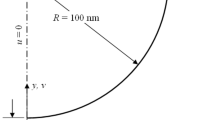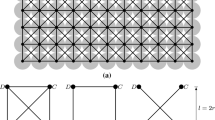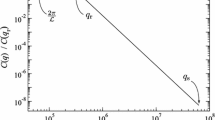Abstract
In this work, we explore the underlying structure of most common bond models used in particle dynamics and discrete element methods, to derive simple equilibrium conditions and stability requirements that must be fulfilled for a model to stand effective and reliable. We then propose a simple model taking into account such considerations, with which we are able to capture inter-particle bonding very straightforwardly once a given bonding criterion is met. The model can be particularized to work with different contact models, such as Hertzian contact, as well as with different adhesion models, such as the classical Johnson, Kendal and Roberts (JKR) model. The derived requirements yield guidelines that may help the selection of proper parameter values (such as, but not only, the stiffness of the bond) for most common bond models, thereby guiding (or even avoiding) burdensome problem-dependent calibration. Numerical examples are provided for illustration.







Similar content being viewed by others
Notes
We will restrict ourselves to the central (or normal) direction of the interaction in this work.
A similar expression may be written to represent the motion of \(j\).
For bonding criterion here we mean, e.g., the temperatures of the particles reaching a certain critical temperature, like their melting temperature, or the concentration of chemical substances reaching a certain critical concentration, for significant sticking or gluing effects to develop.
A similar expression may be derived for damped contacts.
A stick–slip friction scheme (with a Coulomb-type static friction limit) is adopted, as described in details in Campello [11].
References
Johnson KL, Kendall K, Roberts AD (1971) Surface energy and the contact of elastic solids. Proc R Soc London A Math Phys Eng Sci 324:301–313
Jiang M, Yu H-S, Leroueil S (2007) A simple and efficient approach to capturing bonding effect in naturally microstructured sands by discrete element method. Int J Numer Methods Eng 69:1158–1193
Zohdi T (2012) Dynamics of charged particulate systems: modeling, theory and computation. Springer, New York
Zohdi T (2014) A direct particle-based computational framework for electrically-enhanced thermo-mechanical sintering of powdered materials. Math Mech Solids 19(1):93–113
Zohdi T (2014) Additive particle deposition and selective laser processing - A computational manufacturing framework. Comput Mech 54:171–191
Ganeriwala R, Zohdi TI (2014) Multiphysics modeling and simulation of selective laser sintering manufacturing processes. In: Procedia CIRP 14 6th CIRP International Conference on High Performance Cutting, HPC2014, Berkeley, USA, 2014
Oñate E, Zárate F, Miquel J, Santasusana M, Celigueta MA, Arrufat F, Gandikota R, Valiullin K, Ring L (2015) A local constitutive model for the discrete element method. Application to geomaterials and concrete. Comput Particle Mech 2:139–160
Steuben JC, Iliopoulos AP, Michopoulos JG (2016) Discrete element modeling of particle-based additive manufacturing processes. Comput Methods Appl Mech Eng 305:537–561
Xin H, Sun W, Fish J (2018) Discrete element simulations of powder-bed sintering-based additive manufacturing. Int J Mech Sci 149:373–392
Ockelmann F, Dinkler D (2018) A discrete element model for the investigation of the geometrically nonlinear behaviour of solids. Comput Particle Mech 5:335–344
Campello EMB (2018) A computational model for the simulation of dry granular materials. Int J Nonlinear Mech 106:89–107
Brown NJ, Chen J-F, Ooi JY (2014) A bond model for DEM simulation of cementitious materials and deformable structures. Granular Matter 16:299–311
Bicanic N (2004) Discrete Element Methods. In: Stein E, Borst RD, Hughes TJ (eds) Encyclopedia of computational mechanics, vol 1. Wiley, Chichester, pp 1–33
Pöschel T, Schwager T (2004) Computational granular dynamics. Springer, Berlin
Zhu HP, Zhou ZY, Yang RY, Yu AB (2007) Discrete particle simulation of particulate systems: theoretical developments. Chem Eng Sci 62:3378–3392
Zhu HP, Zhou ZY, Yang RY, Yu AB (2008) Discrete particle simulation of particulate systems: a review of major applications and findings. Chem Eng Sci 63:5728–5770
Cleary P (2009) Industrial particle flow modelling using DEM. Eng Comput 29:698–793
Wellmann C, Wriggers P (2012) A two-scale model of granular materials. Comput Methods Appl Mech Eng 205–208:46–58
Sullivan CO (2011) Particle-based discrete element modeling: Geomechanics perspective. Int J Geomech 11:449–464
Thornton AR, Krijgsman D, Fransen R, Gonzalez S, Tunuguntla DR, Voortwis AT, Luding S, Bokhove O, Weinhart T (2013) Mercury-DPM: Fast particle simulations in complex geometries. EnginSof Mag 10(1):48–53
Thornton C, Cummins SJ, Cleary PW (2013) An investigation of the comparative behaviour of alternative contact force models during inelastic collisions. Powder Technol 233:30–46
Casas G, Mukherjee D, Celigueta MA, Zohdi TI, Onate E (2017) A modular, partitioned, discrete element framework for industrial grain distribution systems with rotating machinery. Computat Particle Mechanics 4:181–198
Radjai F, Roux J-N, Daouadji A (2017) Modeling granular materials: century-long research across scales. J Eng Mech 143(4):04017002-1-04017002–20
Lennard-Jones JE (1924) On the determination of molecular fields. Proc R Soc London A 106(738):463–477
Johnson KL (1985) Contact mechanics. Cambridge University Press, Cambridge
Loskofsky C, Song F, Newby BZ (2006) Underwater Adhesion measurements using the JKR technique. J Adhesion 82:713–730
Brilliantov NV, Albers N, Spahn F, Pöschel T (2007) Collision dynamics of granular particles with adhesion. Phys Rev E 76:051302
Avci B, Wriggers P (2012) A DEM-FEM Coupling Approach for the Direct Numerical Simulation of 3D Particulate Flows. J Appl Mech 79:010901-1–7
Campello EMB, Zohdi T (2014) A computational framework for simulation of the delivery of substances into cells. Int J Numer Methods Biomed Eng 30:1132–1152
Campello EMB, Zohdi T (2014) Design evaluation of a particle bombardment system used to deliver substances into cells. Comput Model Eng Sci 98(2):221–245
Campello EMB (2015) A description of rotations for DEM models of particle systems. Comput Particle Mech 2:109–125
Campello EMB (2016) Um modelo computacional para o estudo de materiais granulares, (Habilitation thesis). Escola Politécnica da Universidade de São Paulo, São Paulo
Quintana-Ruiz OD, Campello EMB (2020) A coupled thermo-mechanical model for the simulation of discrete particle systems. J Braz Soc Mech Sci Eng, p (accepted for publication)
Campello EMB, Cassares KR (2015) Rapid generation of particle packs at high packing ratios for DEM simulations of granular compacts. Latin Am J Solids Struct n-a:n-a
Acknowledgements
First author acknowledges support by CNPq (Conselho Nacional de Desenvolvimento Científico e Tecnológico), Brazil, under the Grant 307368/2018-1. Second author acknowledges scholarship funding from Itaipú Binacional, Brazil-Paraguay, through BECAL (Programa Nacional de Becas de Postgrado en el Exterior “Don Carlos Antonio López”), under the grant 590/2016.
Author information
Authors and Affiliations
Corresponding author
Ethics declarations
Conflict of interest
On behalf of all authors, the corresponding author states that there is no conflict of interest.
Additional information
Publisher's Note
Springer Nature remains neutral with regard to jurisdictional claims in published maps and institutional affiliations.
Rights and permissions
About this article
Cite this article
Campello, E.M.B., Quintana-Ruiz, O.D. On a simple, stable and efficient bond model for inter-particle adhesion. Comp. Part. Mech. 9, 29–44 (2022). https://doi.org/10.1007/s40571-021-00388-z
Received:
Revised:
Accepted:
Published:
Issue Date:
DOI: https://doi.org/10.1007/s40571-021-00388-z




